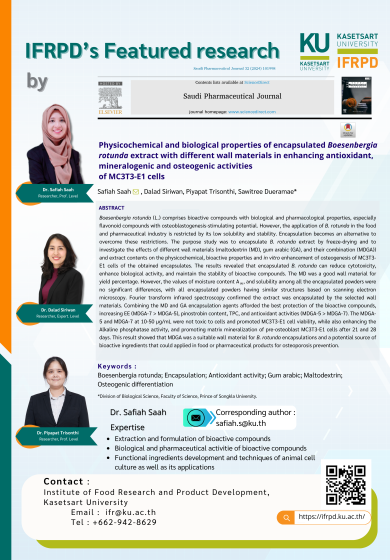Physicochemical and biological properties of encapsulated Boesenbergia rotunda extract with different wall materials in enhancing antioxidant, mineralogenic and osteogenic activities of MC3T3-E1 cells
| ผลงานวิจัย | ดร.ซาฟียะห์ สะอะ และคณะ |
| Keywords | Boesenbergia rotunda; Encapsulation; Antioxidant activity; Gum arabic; Maltodextrin; Osteogenic differentiation |
| Telephone | 0 2942 8629 (1606) |
| Email | Safiah.S@ku.th |
| URL | https://doi.org/10.1016/j.jsps.2024.101998 |
จุดเด่นผลงาน
บทสรุป : กระชายเหลืองเป็นพืชสมุนไพรที่ประกอบด้วยสารออกฤทธิ์ชีวภาพที่มีคุณสมบัติทางชีวภาพและทางเภสัชวิทยา โดยเฉพาะสารประกอบฟลาโวนอยด์ที่มีฤทธิ์ต่อการเสริมสร้างกระดูก อย่างไรก็ตามการประยุกต์ใช้สารสกัดกระชายเหลืองมีข้อจำกัดในเรื่องของความสามารถในการละลายน้ำและความไม่คงตัว เทคนิคการกักเก็บสาร (encapsulation) สามารถลดข้อจำกัดเหล่านี้ได้ การศึกษานี้จึงมีวัตถุประสงค์เพื่อศึกษาการกักเก็บสารสกัดหยาบกระชายเหลืองด้วยสารห่อหุ้มชนิดต่าง ๆ ได้แก่ มอลโตเด็กตรินซ์ (MD), กัมอาราบิก (GA) และสารผสมมอลโทเด็กซ์ทรินกับกัมอาราบิก (MDGA) ด้วยวิธีการทำแห้งแบบแช่เยือกแข็ง ไมโครแคปซูลที่ได้นำมาศึกษาคุณลักษณะทางกายภาพ-เคมี คุณสมบัติการเป็นสารต้านอนุมูลอิสระ และศึกษาสมบัติในการเสริมสร้างกระดูก เช่น การเพิ่มจำนวนเซลล์สร้างกระดูก และการสร้างสารทางชีวเคมีของการสร้างกระดูก (biochemical markers for bone formation) เช่น อัลคาไลฟอสฟาเตสและการสะสมแคลเซียม
จากการศึกษาพบว่า สารห่อหุ้ม MD จะให้ปริมาณผลผลิตไมโครแคปซูลสูงสุด ในขณะที่ประสิทธิภาพการกักเก็บ ปริมาณฟีนอลิกทั้งหมด ปริมาณสารสำคัญ pinostrobin ประสิทธิภาพในการละลาย และประสิทธิภาพการต้านอนุมูลอิสระ จะพบในผงไมโครแคปซูลสารสกัดกระชายเหลืองที่ห่อหุ้มด้วยสารผสม MDGA สูงกว่า GA และ MD และพบว่า ผงไมโครแคปซูลสารสกัดกระชายเหลืองที่ห่อหุ้มด้วย MDGA ที่ความเข้มข้น 10-50 µg/mL นอกจากไม่เป็นพิษต่อเซลล์สร้างกระดูก MC3T3-E1 แล้ว ยังมีฤทธิ์กระตุ้นการเพิ่มจำนวนของเซลล์สร้างกระดูก โดยสามารถเพิ่มการกระตุ้นกิจกรรมเอนไซม์อัลคาไลน์ฟอสฟาเตสและสามารถเพิ่มการสะสมแคลเซียมของเซลล์สร้างกระดูก MC3T3-E1 หลัง 21 และ 28 วัน ของการทดสอบ
จากการศึกษาสรุปได้ว่า สารผสม MDGA เป็นสารห่อหุ้มดีทีสุดสำหรับการห่อหุ้มสารสกัดกระชายเหลือง และมีความเป็นไปได้ในการพัฒนาไปใช้ในผลิตภัณฑ์อาหารเสริมสุขภาพหรืออุตสาหกรรมยาเพื่อเสริมการรักษาหรือหลีกเลี่ยงโรคกระดูกพรุน
Abstract : Boesenbergia rotunda (L.) comprises bioactive compounds with biological and pharmacological properties, especially flavonoid compounds with osteoblastogenesis-stimulating potential. However, the application of B. rotunda in the food and pharmaceutical industry is restricted by its low solubility and stability. Encapsulation becomes an alternative to overcome these restrictions. The purpose study was to encapsulate B. rotunda extract by freeze-drying and to investigate the effects of different wall materials (maltodextrin (MD), gum arabic (GA), and their combination (MDGA)) and extract contents on the physicochemical, bioactive properties and in vitro enhancement of osteogenesis of MC3T3-E1 cells of the obtained encapsulates. The results revealed that encapsulated B. rotunda can reduce cytotoxicity, enhance biological activity, and maintain the stability of bioactive compounds. The MD was a good wall material for yield percentage. However, the values of moisture content Aw, and solubility among all the encapsulated powders were no significant differences, with all encapsulated powders having similar structures based on scanning electron microscopy. Fourier transform infrared spectroscopy confirmed the extract was encapsulated by the selected wall materials. Combining the MD and GA encapsulation agents afforded the best protection of the bioactive compounds, increasing EE (MDGA-7 > MDGA-5), pinostrobin content, TPC, and antioxidant activities (MDGA-5 > MDGA-7). The MDGA-5 and MDGA-7 at 10–50 μg/mL were not toxic to cells and promoted MC3T3-E1 cell viability, while also enhancing the Alkaline phosphatase activity, and promoting matrix mineralization of pre-osteoblast MC3T3-E1 cells after 21 and 28 days. This result showed that MDGA was a suitable wall material for B. rotunda encapsulations and a potential source of bioactive ingredients that could applied in food or pharmaceutical products for osteoporosis prevention.
Saudi Pharmaceutical Journal Volume 32, Issue 4, April 2024, 101998

